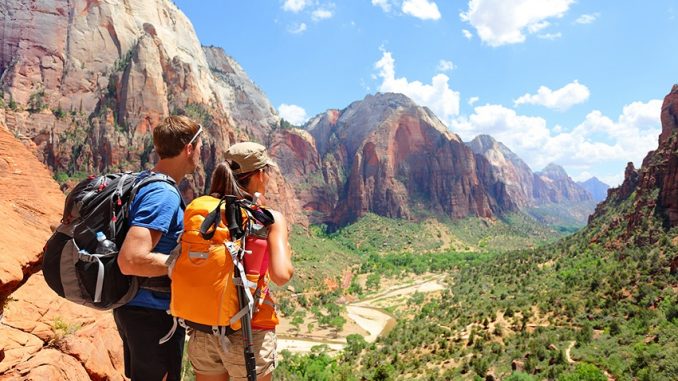
For centuries, hiking has provided an escape into the beauty of the world around us. Hikers find that a good hike can relieve stress, improve health, and bring loved ones closer together. Children and adults alike love the thrill that comes from exploring an unknown world of a serene mountain, or a majestic canyon. Where ever your hike takes you, being prepared can make all the difference in the level of satisfaction your hike will bring you. Hiking preparation involves bringing an adequate supply of food and water, as well as proper hiking attire.
In recent years major improvements have been made in the design and quality of hiking clothing. Great strides have been made that allow you to be comfortable, stay dry, perform well, and look great while camping and hiking. Layering your clothing is the best way to ensure your comfort while enjoying the beautiful outdoors. Layers allow you to quickly adjust your clothing depending on your activity and changes in weather. When layering your clothing it is best to break it down into three basic layers:
- Outer Layer
- Inner Layer
- Base Layer
Outer Layer
The outer layer, or “shell”, protects you from the elements. This layer is critical in bad weather, as it will protect you from the wind, rain or snow. If wind and water are able to penetrate to your inner layers, you begin to feel cold, and could even face hypothermia. High-quality shells also allow for ventilation, allowing your perspiration to evaporate. There are a number of different categories of shells, including waterproof/breathable, water-resistant/breathable, soft, waterproof/non-breathable, and insulated. Be sure to research which kind of shell is best for your activity level and weather you’re most likely to encounter.
Inner Layer
Your middle layer is the most important layer for insulation. Look for natural fibers such as wool, goose down, or fleece. There are a variety of weights you can select for this layer, depending on your activity level and the weather you’re expecting to encounter. Lightweight material is great for aerobic activity or mild climates. The midweight material is used for moderate activity and climates. The expedition-weight material is important for low activity or cold climates.
Base Layer
Your base layer is the layer that is next to your skin. The wicking material is critical, as it draws moisture away from your skin, allowing it to quickly evaporate at the surface. This is important for a couple reasons. First, the moist material may chafe, especially when carrying a pack. This can cause extreme discomfort. Also, keeping your skin dry allows your body to better regulate its temperature. This is critical for hikers who often encounter drastic changes of weather. This base layer could include briefs, sports bras, long underwear, and t-shirts.
Dressed with these basic layers, you are prepared for anything the elements can throw at you while you enjoy the beauty you will encounter. Obviously, it is important to keep in mind the forecast and season in which you will be hiking, as the colder season will require layers with higher insulation. As you prepare for the different circumstances in which you may find yourself on your adventure, you’ll be able to better enjoy the beauty you’ll encounter. Layering will allow you to adapt to these circumstances. Be sure to find high-quality products that will hold up to the environment and wear and tear that you’re sure to expose them to.